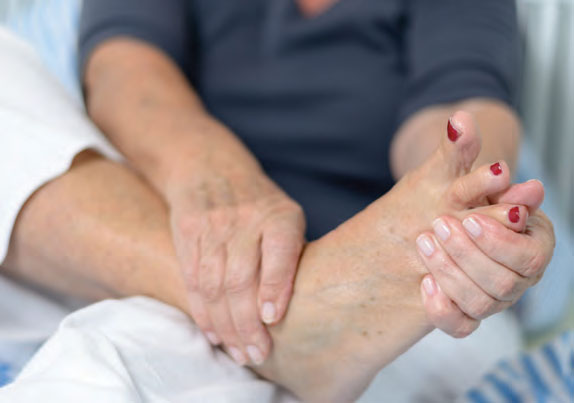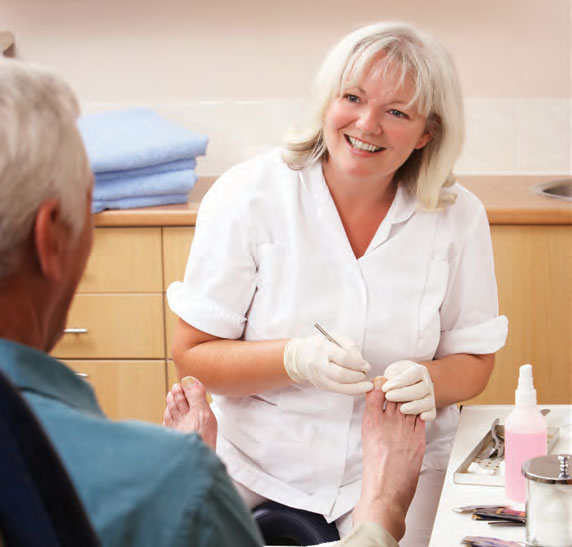
Proper foot care is essential for older adults because it can help prevent injuries, falls, and complications from chronic diseases like diabetes. Learn how to properly care for your feet so they can continue to take you wherever you need to go.
-
- Be good to your soles. As you age, the muscle tissue in your feet can thin and your nerves may not work effectively. This can lead to loss of feeling in your feet (neuropathy). Use a long-handled mirror – it will extend your reach several inches – to see what you may not feel. Examine the soles of your feet and in-between your toes every day for cuts, blisters, sores or any areas of skin breakdown from moisture. This is especially important if you have diabetes.
- Choose the right footwear. Wearing the right footwear can help you keep your balance, prevent falls and reduce the risk of blisters and other injuries. Never purchase shoes that rub or slide around on your heel as you walk – this is a common way to develop blisters that can become more serious sores. Also avoid shoes that are too tight, slick on the bottom, have high heels or pointy toes.
If you have diabetes or neuropathy, talk with your doctor about prescription orthotics (supports or devices worn in your shoes). You may be eligible for custom orthotics partially covered by Medicare. - Get the right fit. Here are a few suggestions:
- Visit the shoe store in the afternoon when your feet are slightly swollen from daily activities.
- Have a sales associate measure your feet so you can select the correct size. It’s normal for your feet to change sizes slightly as you age.
- Choose the shoe size that fits your larger foot (it’s common to have one foot that’s bigger than the other).
- Always try on shoes before you buy them to make sure they fit. A good rule of thumb: your toes should be half an inch from the tips of your shoes when you are standing.
- Barefoot isn’t better. When going outdoors, always wear shoes (preferably closed-toe shoes) to prevent cuts, scrapes, and falls. It’s also best to wear shoes as much as possible while indoors to protect your feet.
- Keep your toenails in tip-top shape. Trimming your toenails correctly (straight across and no shorter than the tip of your toe) is key for preventing ingrown toenails. If you have diabetes or trouble reaching your feet, see a podiatrist (a physician who specializes in foot care), not a nail salon technician, for regular medical pedicures and nail trimming.
- Get the blood flowing. As you age, you may have decreased blood circulation to your feet. To promote healthy circulation:
- Prop up your feet on a stool or couch when sitting down
- Wiggle your toes when you sit for long periods of time
- Stretch daily
- Give yourself regular foot massages
- Keep your feet dry. Change your socks regularly and make sure your feet aren’t damp from sweat or a shower before putting on your shoes.
- But not too dry. Keep your feet moisturized to prevent cracking, itching and calluses. Stick with gentle soap and apply cream or lotion daily after your shower or bath.
- Fight fungal infections. Prevent athlete’s foot by wearing shoes that fit properly, changing your socks or stockings daily (or whenever they become damp) and applying foot powder each day. If you experience itching or burning, see your podiatrist for treatment.
- Visit your podiatrist regularly for foot checks. Your podiatrist can catch problems like bone spurs, hammertoe, neuromas, bunions, warts, ingrown toenails or wounds before they cause more serious problems.
And, if you smoke, now’s the time to quit. Smoking can affect good circulation in the body.

Please join us April 18th at 1:30 pm in the PAC for our Smart Moves presentation on this topic.





 © 2025 Kirby Pines LifeCare Community. All Rights Reserved |
© 2025 Kirby Pines LifeCare Community. All Rights Reserved | 